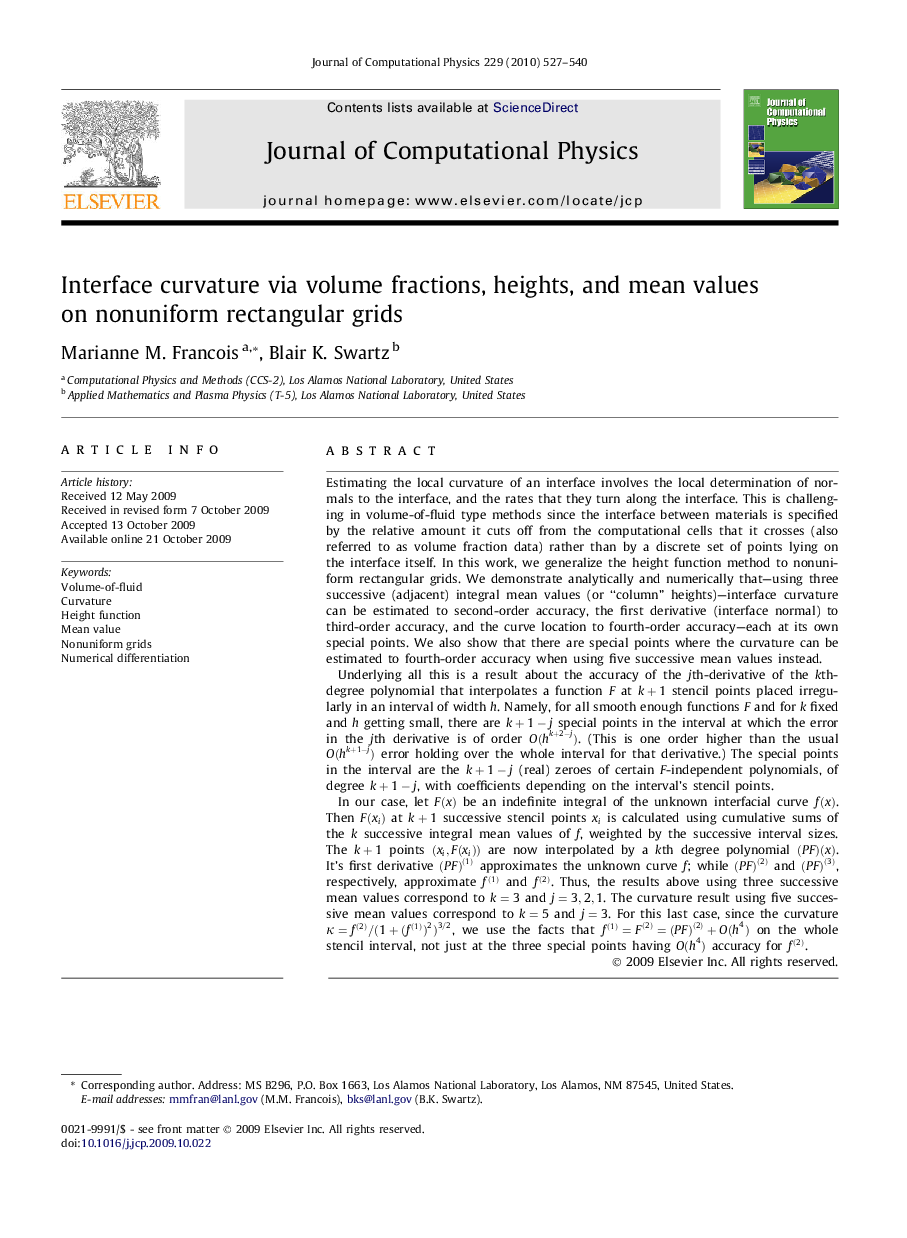| کد مقاله | کد نشریه | سال انتشار | مقاله انگلیسی | نسخه تمام متن |
|---|---|---|---|---|
| 521454 | 867769 | 2010 | 14 صفحه PDF | دانلود رایگان |

Estimating the local curvature of an interface involves the local determination of normals to the interface, and the rates that they turn along the interface. This is challenging in volume-of-fluid type methods since the interface between materials is specified by the relative amount it cuts off from the computational cells that it crosses (also referred to as volume fraction data) rather than by a discrete set of points lying on the interface itself. In this work, we generalize the height function method to nonuniform rectangular grids. We demonstrate analytically and numerically that—using three successive (adjacent) integral mean values (or “column” heights)—interface curvature can be estimated to second-order accuracy, the first derivative (interface normal) to third-order accuracy, and the curve location to fourth-order accuracy—each at its own special points. We also show that there are special points where the curvature can be estimated to fourth-order accuracy when using five successive mean values instead.Underlying all this is a result about the accuracy of the jth-derivative of the kth-degree polynomial that interpolates a function F at k+1k+1 stencil points placed irregularly in an interval of width h. Namely, for all smooth enough functions F and for k fixed and h getting small, there are k+1-jk+1-j special points in the interval at which the error in the j th derivative is of order O(hk+2-j)O(hk+2-j). (This is one order higher than the usual O(hk+1-j)O(hk+1-j) error holding over the whole interval for that derivative.) The special points in the interval are the k+1-jk+1-j (real) zeroes of certain F -independent polynomials, of degree k+1-jk+1-j, with coefficients depending on the interval’s stencil points.In our case, let F(x)F(x) be an indefinite integral of the unknown interfacial curve f(x)f(x). Then F(xi)F(xi) at k+1k+1 successive stencil points xixi is calculated using cumulative sums of the k successive integral mean values of f , weighted by the successive interval sizes. The k+1k+1 points (xi,F(xi))(xi,F(xi)) are now interpolated by a k th degree polynomial (PF)(x)(PF)(x). It’s first derivative (PF)(1)(PF)(1) approximates the unknown curve f ; while (PF)(2)(PF)(2) and (PF)(3)(PF)(3), respectively, approximate f(1)f(1) and f(2)f(2). Thus, the results above using three successive mean values correspond to k=3k=3 and j=3,2,1j=3,2,1. The curvature result using five successive mean values correspond to k=5k=5 and j=3j=3. For this last case, since the curvature κ=f(2)/(1+(f(1))2)3/2κ=f(2)/(1+(f(1))2)3/2, we use the facts that f(1)=F(2)=(PF)(2)+O(h4)f(1)=F(2)=(PF)(2)+O(h4) on the whole stencil interval, not just at the three special points having O(h4)O(h4) accuracy for f(2)f(2).
Journal: Journal of Computational Physics - Volume 229, Issue 3, 1 February 2010, Pages 527–540